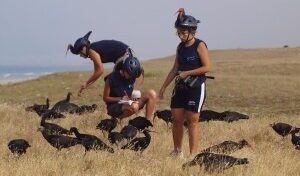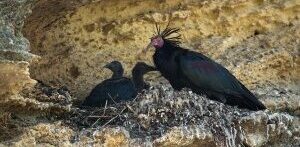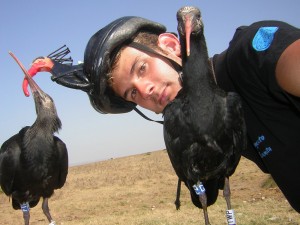Species: Northern Bald Ibis

The Northern Bald Ibis (NBI) is one of the world’s most threatened birds, listed as Critically Endangered (CR) on the IUCN Red List. The historical range ofGeronticus eremita probably extended throughout North Africa and into the Middle East. Since the beginning of the 20th century, however, the species has been known as two disjunct populations: a western population in Morocco currently estimated at 300 individuals, and an eastern migratory population between Syria and Ethiopia (less than 5 individuals) and in Turkey where only 180 semi-captive birds remain (BirdLife International, 2015).
Between 2004 and 2011 an experimental programme, “Proyecto Eremita”, was accomplished in La Janda (Cádiz, southwestern Spain) to evaluate the efficiency of different breeding and releasing techniques of ibises coming from the European Endangered Species Programme (NBI EEP) aimed at establishing sedentary populations of this species in the area.
The “Proyecto Eremita” was developed by the regional government of Andalusia (Junta de Andalucía) and ZooBotánico Jerez in collaboration with the European Association of Zoos and Aquaria (EAZA) and scientifically advised by Estación Biológica de Doñana (EBD-CSIC). The success of that project encouraged its promoters to undertake the reintroduction program in Andalusia starting in 2013.

As a result of the “Proyecto Eremita” and the reintroduction program, La Janda currently has a wild population of roughly 80 individuals first established in 2008 as a small breeding colony in Vejer de la Frontera (Cádiz), reaching 25 breeding pairs in 2014.
Among the next challenges for the team are the assessments of population viability, as well as advancing the knowledge of the ecology of this rare bird. To this end, from 2014 GPS tracking of some adults and juvenile birds was conducted to improve insights into threats to the species and ecological requirements (Vázquez et al., 2015). Thanks to the Uva-BiTS system we are compiling a high-resolution movement data set through which we intend to study the responses to variations in the internal and external factors of the individuals in an integrated framework for conservation under global change.

In addition to improving knowledge about the ecology of the species, this kind of study is designed to aid conservation efforts in the face of threats to biodiversity such as habitat loss, land-use changes, biological invasions, extreme weather variations and other drivers of global change.
Publications
- BirdLife International. (2015). Retrieved from http://www.birdlife.org/
- Vázquez, J. M. L., Muñoz, M. A. Q., García, I. S., Martín, B. R., Real, D. G., & Prieto, E. A. (2015). Crónica de la reintroducción del “ibis eremita” en Andalucía. Quercus, (349), 14–23.
Contact persons, funders and participants
Rafa Silva rafasilva@ebd.csic.es Estación Biológica de Doñana EBD-CSIC, Sevilla (Spain)

Javier Bustamante jbustamante@ebd.csic.es Estación Biológica de Doñana EBD-CSIC, Sevilla (Spain)
José Manuel López Vázquez josem.lopez.vazquez@juntadeandalucia.es Consejería de Medio Ambiente. Junta de Andalucía, Sevilla (Spain)
Willem Bouten – w.bouten@uva.nl Universiteit van Amsterdam
Zoobotánico Jerez
Proyecto Eremita

